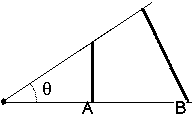TAPESTRY: The Art of Representation and Abstraction
Radiosity Overview
And Now For Something Completely Different
Radiosity represents an interesting convergence oflighting simulation and rendering. Up to this point lip-service has been paid to Lambert's law in the fundamental cosine shading equation, but great liberties have been taken with fall-off rates, surface textures, etc. All of this is done to achieve a believable image, not necessarily an accurate image. Radiosity is different. It offers the possibility of being believable and accurate. It does this by invoking the theory of radiant exchange.

Radiant Exchange Between Surfaces
The illustration at right shows part of the interior of a small room. The wall surfaces have been divided into several rectangular regions, called surface "nodes". The logic of radiosity goes like this:- Assume the surface node can be represented by a point at it's center.
- Establish nodes on each surface of the room, so that no light escapes, no nodes overlap, and so on.
- Now, it's clear that all the light leaving a given node MUST arrive at the other nodes (there is nowhere else for it to go).
- The amount of light reaching any other node is somehow proportional to the size of the node and the location. This number, expressed as a decimal fraction in the range of 0.0 to 1.0, is called an angle factor. (see below)
- Begin the processing by calculating all the angle-factors. There is an angle-factor between every pair of wall nodes, so the number can be quite large and can take quite a bit of time. However, since these numbers depend solely on the geometry, they will not be different as we change view points, so we'll be able to reuse them later!
- Now, using whatever light-emitters you have (windows, light fixtures, etc.) establish an initial "direct" distribution of light energy in the room. This "charges up" each node.
- Now loop through each node, "distributing" it's energy to the other nodes in proportion to the angle-factors.
- Keep looping through all the nodes until the "before" and "after" energy levels aren't changing very much. Call this done!
- Display the image, possibly with some additional image processing along the way.
|
Angle-factors The concept of an angle factor may be easier to understand in terms of the 2D situation diagrammed at right. A small wall at point A obscures, or subtends the same angle as a large wall further away, at point B. The light leaving the "node" (at the point of the triangle) is leaving in all directions uniformly (where have we seen that before!). So if a surface subtends 1/4 of the semi-circle (the surface only radiates on one side), it must be getting one third of the energy. We would say that it has an angle factor (or shape factor) of 0.25. |  |
Last updated: April, 2014
